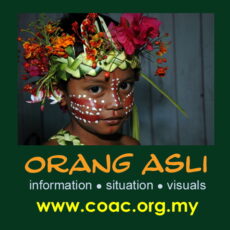The Ipoh High Court affirmedon 30 September 2015 that the Semai of Kampung Senta in Bidor, Perak enjoyed native title rights to their tanah adat (customary lands) under common law.
Following on the precedents of Sagong Tasi, Nor ak Nyawai and Madelli Salleh – important precedent-setting land rights cases in Selangor and Sarawak – Justice Dato’ Che Mohd Ruzina bin Ghazah accepted the plaintiff’s testimony, which was supported by the expert report and oral evidence of Colin Nicholas, that they are the traditional owners of the land since early times.
The court also noted that there was no credible challenge to these testimonies from the defence side. (See http://on.fb.me/1KQ2LJ8 for an earlier report on this.)

Background of the case
In 2010, the Semai of Kampung Senta found that representatives of a company, later found out to be Bionest Corporation Sdn Bhd (“Bionest”), had been encroaching on their land and challenged their rights to it.
On 3.9.2014, Bionest filed a suit against the Orang Asli, alleging that part of the Semai’s customary lands had been alienated to them and got the Court to issue an eviction order to the Semai.
In response, Kong Chee Wai and Bah Kana a/l Bah Ngah, in their personal and representative capacity for 142 other villagers, filed their own counter-suit.
They sought, amongst others, declarations that the said lands were Orang Asli customary lands and as such the same belonged to the Semai Peoples of Kampung Senta. They also asked that the part of the said lands that had been alienated to Bionest be returned to them.
Bah Tony explaining the outcome of the case to the Semai villagers.
Decision
Amongst other orders, the Court in fact declared that the said lands were in fact the Semai’s customary lands. Based on the ‘indicative map’ produced by the Semai, the area concerned is 2,209 hectares (5,460 acres).
The Court also found that the Government had failed in its fiduciary duty to gazette the lands concerned as an Orang Asli reserve and as such instructed the State Government to now measure and gazette the land as an Orang Asli reserve.
This includes the part of the customary lands which had been already been alienated to Bionest. Such lands are to be excised from the alienation and be gazetted as Orang Asli Reserve.
However, the pieces of land now worked by Chinese farmers (to grow guava and papaya) are to be excluded from the tanah adat as by allowing the Chinese farmers to work the land, on a pajak basis, before, and now without any contractual arrangement, meant that the Orang Asli plaintiffs have abandoned their claim (and rights) to that portion of the customary lands. (These lands total about 50 acres.)
The lawyers briefing Colin before he went on the stand on 6 August 2015.
Lawyers
The solicitor on record for this case was Amani Williams-Hunt (Bah Tony). Ably assisting him were Aaron Mathews, Darmain Segaran and Dr. Yogeswaran Subramaniam, all working pro bono from the Committee for Orang Asli Rights (COAR) of the Malaysian Bar Council.
This is the first case where the Semai community had taken their case to court and won. Other subgroups that have done so and won at the High Court stage include the Temuan, Orang Seletar and the Semelai. Other cases still pending involve the Temiar, Semaq Beri, Jakun and another two involving other Orang Seletar and Semai communities.
CN-COAC | 1 October 2015
Some of the villagers anxiously waiting for the court to be called to session.
A set of photos was submitted to the Court as a Supplementary Appendix to the Expert Report. This was to help the Court visualise the situation and geography on the ground as a site visit was not on the cards. You can view these photos at: http://bit.ly/1VrxXDu


The site of the old village is still forested with some parts planted with oil palm.

Pieces of land now worked by Chinese farmers (to grow guava and papaya) are to be excluded from the tanah adat as by allowing the Chinese farmers to work the land, on apajak basis, before, and now without any contractual arrangement, meant that the Orang Asli plaintiffs have abandoned their claim (and rights) to that portion of the customary lands.

